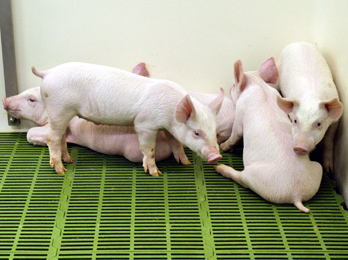Pig genome sequenced

15/11/2012
Economically speaking, the pig is one of the most important livestock species, together with cows and chickens, and it was the only one of the three that had yet to be sequenced. This genome without a doubt will help to understand the physiology, productive traits and history of the pig. It also will have important effects on the use of this animal in biomedicine. For example, the pig contains a variety of mutations whose effects - in humans - are associated with an increase in the risk of suffering disorders such as Alzheimer's disease, diabetes and also curiously, dyslexia. In addition, it will allow for more in detail study of risks implied in xenotransplantations (transplants using tissues from other species).
The consortium has been able to identify 21,000 genes, similar to that sequenced in other mammals. Worth highlighting is the fact that the pig is a species which presents a larger number of functional genes related to smell, demonstrating the importance this sense has for species, and which has helped this animal find food by digging up dirt, to the horror of farmers. The study also demonstrates that the evolution of many genes related to taste has varied from that undergone by humans. In fact, pigs are capable of eating food that other species cannot, since they do not perceive bitterness. These results therefore explain why pigs really eat all kinds of things.
Traditionally, sequencing consisted in the analysis of one genome (what is known as the reference genome, which in this case was from a female sample of the Duroc breed). However, new sequencing technologies are available at much lower costs to such an extent that full genome sequencing can be afforded by the most modest laboratories, even now in times of crisis. That is why it is not strange that the study published in Nature also includes the sequence and analysis of 48 additional pigs, including several wild boars, both from China and from Europe.
The interest in sequencing animals from China and Europe is due to the fact that this species, Sus scrofa, appeared in southeastern Asia four million years ago and since then has extended into almost all of Eurasia, including Europe and the north of Africa. The international consortium has been able to date the separation between Asian and European boars, which took place approximately one million years ago. Much later, some 10,000 years ago, humans achieved to obtain domesticated pigs from boars. This domestication occurred independently in various different places, in both Europe and China. Therefore, when Marco Polo arrived in China in the 13th century he found that domesticated pigs already existed, and that their origins were completely different from the domesticated pigs in Europe. However, the most interesting part is that through the Portuguese and their travels to Asia, and especially with the English in the 17th century, Chinese pigs were being imported into Europe and cross breeding commenced with European pigs. In those times, Chinese pigs were imported because they were more docile and especially much fatter than their European counterparts. These hybrid pigs, in turn, gave way two centuries later to the international pig breeds we know today. The study conducted by the international consortium demonstrates what was already known but qualifies it with precision: approximately 30% of the genome of international breeds are of Chinese origin.
And what about the Iberian pig? What is presently known is that the Iberian pig was not crossed with any of the Asian breeds. In fact, a partial sequencing of the Iberian pig conducted by Pérez Enciso's research team was published last year in the journal Heredity and other previous studies conducted by INIA researchers (Instituto Nacional de Investigación y Tecnología Agraria y Alimentaria) attest the same. The same research team will soon publish a much more complete sequence of the Iberian pig which also confirms it. In fact, this latest study on the Iberian pig genome suggests that this pig breed contains genes which have been subject to their own selection processes, among which are the lipid metabolism-related genes.
Miguel Pérez Enciso concludes: "the study published in Nature represents a milestone in animal genome and its effects at scientific, technological and biomedical levels will soon be noticed".
The research was financed mainly by the US Department of Agriculture, the European Union, the BBSRC and the British Wellcome Trust, as well as European and American firms.